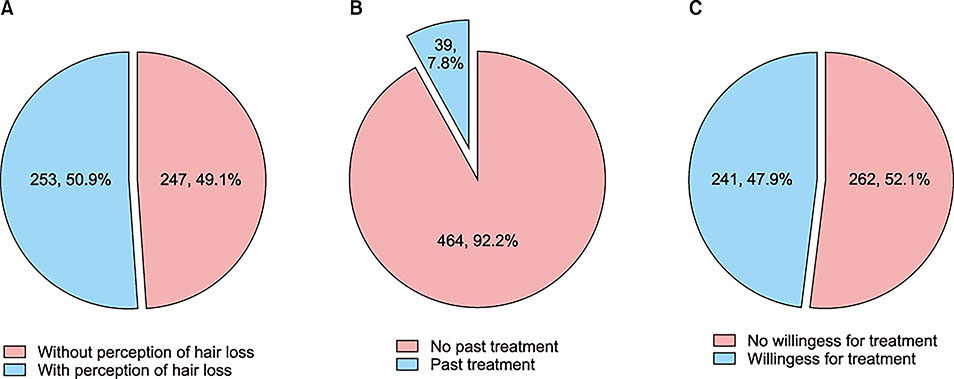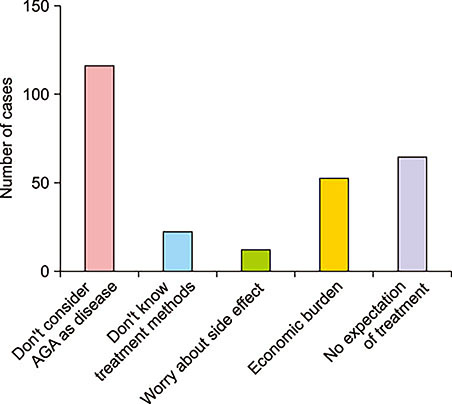Ann Dermatol.
2018 Aug;30(4):402-408. 10.5021/ad.2018.30.4.402.
Perception of Hair Loss and Education Increases the Treatment Willingness in Patients With Androgenetic Alopecica: A Population-Based Study
- Affiliations
-
- 1Department of Dermatology and Institute of Hair and Cosmetic Medicine, Yonsei University Wonju College of Medicine, Wonju, Korea. leewonsoo@yonsei.ac.kr
- 2Department of Occupational and Environmental Medicine, Yonsei University Wonju College of Medicine, Wonju, Korea.
- KMID: 2457516
- DOI: http://doi.org/10.5021/ad.2018.30.4.402
Abstract
- BACKGROUND
Androgenetic alopecia (AGA) has a negative impact on self-image and decrease in quality of life. However, relatively few men have sought treatment for AGA. Improvement in treatment willingness is important for maintaining long-term management in patients with AGA.
OBJECTIVES
We aimed to identify the prevalence of patients' perception of hair loss and evaluate various factors that affect the treatment willingness in patients with AGA.
METHODS
We conducted a population-based cross-sectional survey of 503 patients with AGA (329 men, 174 women). We collected the various demographic data, family history of AGA, history of past treatment, self-perception of hair loss and treatment willingness using structured questionnaires. Then, we provided the knowledge about AGA to the half of subjects and compared the treatment willingness between educated group and nond-educated group.
RESULTS
Two-hundred and forty-seven out of 503 patients (49.1%) did not have illness perception and 262 out of 503 patients (52.1%) did not have treatment willingness in future. The patients with perception of hair loss, accurate information on hair loss and severe hair loss showed 1.745-fold, 1.700-fold, and 2.078-fold higher tendency of receiving treatment in future.
CONCLUSION
Our findings imply that patients with perception and greater understanding of AGA tend to pursue treatment for AGA. Thus, these elements should be taken into account when treating patients. In addition, emphasis on education is needed to increase public awareness of the AGA.
Keyword
Figure
Reference
-
1. Ayob SM, Messenger AG. Androgens, hair loss and eugenics: a tale of discovery and American social history. Exp Dermatol. 2015; 24:412–413.
Article2. Muscarella F, Cunningham MR. The evolutionary significance and social perception of male pattern baldness and facial hair. Ethol Sociobiol. 1996; 17:99–117.
Article3. Neave N, Shields K. The effects of facial hair manipulation on female perceptions of attractiveness, masculinity, and dominance in male faces. Pers Indiv Differ. 2008; 45:373–377.
Article4. Lee WS, Lee HJ. Characteristics of androgenetic alopecia in asian. Ann Dermatol. 2012; 24:243–252.
Article5. Schmitt JV, Ribeiro CF, Souza FH, Siqueira EB, Bebber FR. Hair loss perception and symptoms of depression in female outpatients attending a general dermatology clinic. An Bras Dermatol. 2012; 87:412–417.
Article6. Lee HJ, Ha SJ, Kim D, Kim HO, Kim JW. Perception of men with androgenetic alopecia by women and nonbalding men in Korea: how the nonbald regard the bald. Int J Dermatol. 2002; 41:867–869.
Article7. Girman CJ, Rhodes T, Lilly FR, Guo SS, Siervogel RM, Patrick DL, et al. Effects of self-perceived hair loss in a community sample of men. Dermatology. 1998; 197:223–229.
Article8. Franzoi SL, Anderson J, Frommelt S. Individual differences in men's perceptions of and reactions to thinning hair. J Soc Psychol. 1990; 130:209–218.
Article9. Dixson BJ, Brooks RC. The role of facial hair in women's perceptions of men's attractiveness, health, masculinity and parenting abilities. Evol Hum Behav. 2013; 34:236–241.
Article10. Chiang YZ, Bundy C, Griffiths CE, Paus R, Harries MJ. The role of beliefs: lessons from a pilot study on illness perception, psychological distress and quality of life in patients with primary cicatricial alopecia. Br J Dermatol. 2015; 172:130–137.
Article11. Cash TF. The psychosocial consequences of androgenetic alopecia: a review of the research literature. Br J Dermatol. 1999; 141:398–405.
Article12. Alfonso M, Richter-Appelt H, Tosti A, Viera MS, García M. The psychosocial impact of hair loss among men: a multinational European study. Curr Med Res Opin. 2005; 21:1829–1836.
Article13. Olsen EA, Messenger AG, Shapiro J, Bergfeld WF, Hordinsky MK, Roberts JL, et al. Evaluation and treatment of male and female pattern hair loss. J Am Acad Dermatol. 2005; 52:301–311.
Article14. Lee WS, Ro BI, Hong SP, Bak H, Sim WY, Kim DW, et al. A new classification of pattern hair loss that is universal for men and women: basic and specific (BASP) classification. J Am Acad Dermatol. 2007; 57:37–46.
Article15. Group KHRS. Diagnosis and treatment guideline of androgenetic alopecia [Internet]. Wonju: The Korean Hair Research Society;2011. 11. 06. updated 2011 Dec 6. cited 2012 Aug 12. Available from: http://www.khrs.or.kr/library/operation.16. Robbins C, Mirmirani P, Messenger AG, Birch MP, Youngquist RS, Tamura M, et al. What women want - quantifying the perception of hair amount: an analysis of hair diameter and density changes with age in caucasian women. Br J Dermatol. 2012; 167:324–332.
Article17. Wogalter MS, Hosie JA. Effects of cranial and facial hair on perceptions of age and person. J Soc Psychol. 1991; 131:589–591.
Article18. van der Donk J, Passchier J, Knegt-Junk C, van der Wegen-Keijser MH, Nieboer C, Stolz E, et al. Psychological characteristics of women with androgenetic alopecia: a controlled study. Br J Dermatol. 1991; 125:248–252.
Article19. Van Der Donk J, Hunfeld JA, Passchier J, Knegt-Junk KJ, Nieboer C. Quality of life and maladjustment associated with hair loss in women with alopecia androgenetica. Soc Sci Med. 1994; 38:159–163.
Article20. Hunt N, McHale S. The psychological impact of alopecia. BMJ. 2005; 331:951–953.
Article21. Grimalt R. Psychological aspects of hair disease. J Cosmet Dermatol. 2005; 4:142–147.
Article22. Cash TF, Price VH, Savin RC. Psychological effects of androgenetic alopecia on women: comparisons with balding men and with female control subjects. J Am Acad Dermatol. 1993; 29:568–575.
Article23. Cash TF. The psychological effects of androgenetic alopecia in men. J Am Acad Dermatol. 1992; 26:926–931.
Article24. Stough D, Stenn K, Haber R, Parsley WM, Vogel JE, Whiting DA, et al. Psychological effect, pathophysiology, and management of androgenetic alopecia in men. Mayo Clin Proc. 2005; 80:1316–1322.
Article25. Cartwright T, Endean N, Porter A. Illness perceptions, coping and quality of life in patients with alopecia. Br J Dermatol. 2009; 160:1034–1039.
Article26. Warren RB, Kleyn CE, Gulliver WP. Cumulative life course impairment in psoriasis: patient perception of disease-related impairment throughout the life course. Br J Dermatol. 2011; 164:Suppl 1. 1–14.
Article27. Randell RL, Long MD, Martin CF, Sandler RS, Chen W, Anton K, et al. Patient perception of chronic illness care in a large inflammatory bowel disease cohort. Inflamm Bowel Dis. 2013; 19:1428–1433.
Article28. Piana N, Battistini D, Urbani L, Romani G, Fatone C, Pazzagli C, et al. Multidisciplinary lifestyle intervention in the obese: its impact on patients' perception of the disease, food and physical exercise. Nutr Metab Cardiovasc Dis. 2013; 23:337–343.
Article29. Mosca L, Jones WK, King KB, Ouyang P, Redberg RF, Hill MN. Awareness, perception, and knowledge of heart disease risk and prevention among women in the United States. American Heart Association Women's Heart Disease and Stroke Campaign Task Force. Arch Fam Med. 2000; 9:506–515.
Article30. Metz U, Welke J, Esch T, Renneberg B, Braun V, Heintze C. Perception of stress and quality of life in overweight and obese people--implications for preventive consultancies in primary care. Med Sci Monit. 2009; 15:PH1–PH6.31. Linder D, Dall'olio E, Gisondi P, Berardesca E, Gennaro ED, Pennella AR, et al. Perception of disease and doctor-patient relationship experienced by patients with psoriasis: a questionnaire-based study. Am J Clin Dermatol. 2009; 10:325–330.
Article32. Daudén E, Conejo J, García-Calvo C. [Physician and patient perception of disease severity, quality of life, and treatment satisfaction in psoriasis: an observational study in Spain]. Actas Dermosifiliogr. 2011; 102:270–276. Spanish.
Article33. Esteban y Peña MM, Hernandez Barrera V, Fernández Cordero X, Gil de Miguel A, Rodríguez Pérez M, Lopez-de Andres A, et al. Self-perception of health status, mental health and quality of life among adults with diabetes residing in a metropolitan area. Diabetes Metab. 2010; 36:305–311.
Article34. Choi H, Park JY, Yeo JK, Oh MM, Moon du G, Lee JG, et al. Population-based survey on disease insight, quality of life, and health-seeking behavior associated with female urinary incontinence. Int Neurourol J. 2015; 19:39–46.
Article35. Litaker D, Mion L, Planavsky L, Kippes C, Mehta N, Frolkis J. Physician - nurse practitioner teams in chronic disease management: the impact on costs, clinical effectiveness, and patients' perception of care. J Interprof Care. 2003; 17:223–237.
Article36. Le Grande MR, Elliott PC, Worcester MU, Murphy BM, Goble AJ, Kugathasan V, et al. Identifying illness perception schemata and their association with depression and quality of life in cardiac patients. Psychol Health Med. 2012; 17:709–722.
Article37. Zeremski M, Dimova RB, Zavala R, Kritz S, Lin M, Smith BD, et al. Hepatitis C virus-related knowledge and willingness to receive treatment among patients on methadone maintenance. J Addict Med. 2014; 8:249–257.
Article
- Full Text Links
- Actions
-
Cited
- CITED
-
- Close
- Share
- Similar articles
-
- Alopecia
- Characteristics of Androgenetic Alopecia in Asian
- Representative Trichoscopic Findings of Outpatients with Androgenetic Alopecia and Alopecia Areata
- A Clinical Study of the Effects of Finasteride on Androgenetic Alopecia
- The physiological and pharmacological roles of prostaglandins in hair growth



